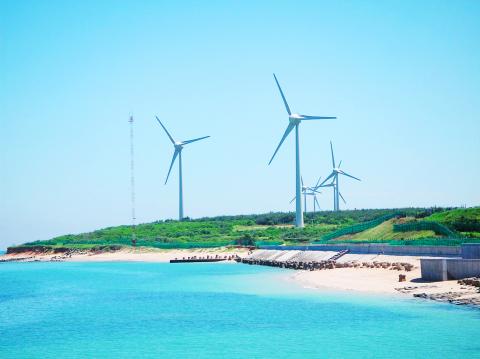State-run Taiwan Power Co (Taipower, 台電) yesterday said construction of 11 new onshore wind turbines at three locations in Penghu County is to be completed in 2020, as part of the government’s initiative to turn Penghu into a low-carbon-footprint island.
Taipower said it is to build six 3 megawatt (MW) onshore turbines in Penghu’s Longmen Village (龍門), two in Jiangmei Village (講美) and three in Chikan Village (赤崁).
The number of onshore wind turbines in Penghu would increase to 25 from 14 after three years of construction, boosting the combined installed capacity to 43.2MW from 10.2MW, said Chen I-cheng (陳一成), director of Taipower’s department of renewable energy.

Photo courtesy of Taiwan Power Co
As a result, Penghu’s onshore wind farms would be capable of generating 150 million kilowatt-hours (kWh), up from the current level of about 26kWh, Taipower said.
The utility plans to allocate NT$2.5 billion (US$83.31 million) to the project, Chen said, adding that the region is seen as one of the best places in the nation to develop wind power.
“Penghu is expected to have sufficient wind power supply in winter [as the result of the new turbines],” he said, citing the strong northeasterly monsoon winds in winter.
In an effort to ensure a stable power supply, Taipower is also building a 67.9km-long underwater cable between Taiwan proper and Penghu — with the first phase of construction to be completed in November next year — for its offshore wind farms.
Taipower plans to construct 20 offshore wind turbines in Penghu with a combined installed capacity of 140MW, the utility said, adding that the facilities are set to begin operations in 2023 at the earliest.
Using the underwater cable, Taiwan could supply electricity to Penghu when the wind farms are not capable of satisfying power demand in summer, while the excess electricity generated in Penghu during fall and winter can be transmitted to Taiwan.
Investment in Penghu’s wind farms has led to a reduction of more than 9,000 tonnes of carbon dioxide emissions per year, Taipower said.
Penghu’s existing 14 turbines last year produced a total of 26.37kWh of electricity, contributing 6.4 percent of the island’s total electricity, while electricity generated by diesel engines and solar power systems made up 91.49 percent and 2.11 percent respectively.
The wind farms helped the local government save NT$118 million in fuel oil costs last year, Taipower said.
The ongoing wind power project is in line with the Cabinet’s goal of raising electricity generated from renewable energy from 4.8 percent last year to 20 percent in 2025.

With this year’s Semicon Taiwan trade show set to kick off on Wednesday, market attention has turned to the mass production of advanced packaging technologies and capacity expansion in Taiwan and the US. With traditional scaling reaching physical limits, heterogeneous integration and packaging technologies have emerged as key solutions. Surging demand for artificial intelligence (AI), high-performance computing (HPC) and high-bandwidth memory (HBM) chips has put technologies such as chip-on-wafer-on-substrate (CoWoS), integrated fan-out (InFO), system on integrated chips (SoIC), 3D IC and fan-out panel-level packaging (FOPLP) at the center of semiconductor innovation, making them a major focus at this year’s trade show, according

DEBUT: The trade show is to feature 17 national pavilions, a new high for the event, including from Canada, Costa Rica, Lithuania, Sweden and Vietnam for the first time The Semicon Taiwan trade show, which opens on Wednesday, is expected to see a new high in the number of exhibitors and visitors from around the world, said its organizer, SEMI, which has described the annual event as the “Olympics of the semiconductor industry.” SEMI, which represents companies in the electronics manufacturing and design supply chain, and touts the annual exhibition as the most influential semiconductor trade show in the world, said more than 1,200 enterprises from 56 countries are to showcase their innovations across more than 4,100 booths, and that the event could attract 100,000 visitors. This year’s event features 17

Germany is to establish its first-ever national pavilion at Semicon Taiwan, which starts tomorrow in Taipei, as the country looks to raise its profile and deepen semiconductor ties with Taiwan as global chip demand accelerates. Martin Mayer, a semiconductor investment expert at Germany Trade & Invest (GTAI), Germany’s international economic promotion agency, said before leaving for Taiwan that the nation is a crucial partner in developing Germany’s semiconductor ecosystem. Germany’s debut at the international semiconductor exhibition in Taipei aims to “show presence” and signal its commitment to semiconductors, while building trust with Taiwanese companies, government and industry associations, he said. “The best outcome

Semiconductor equipment billings in Taiwan are expected to double this year, as manufacturers in the industry are keen to expand production to meet strong global demand for artificial intelligence applications, according to SEMI, which represents companies in the electronics manufacturing and design supply chain. Speaking at a news conference before the opening of Semicon Taiwan trade show tomorrow, SEMI director of industry research and statistics Clark Tseng (曾瑞榆) said semiconductor equipment billings in Taiwan are expected to grow by an annual 100 percent this year, beating an earlier estimate of 70 percent growth. He said that Taiwan received a boost from a